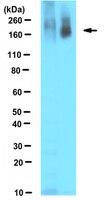DNA repair biomarkers predict response to neoadjuvant chemoradiotherapy in esophageal cancer.
Alexander, BM; Wang, XZ; Niemierko, A; Weaver, DT; Mak, RH; Roof, KS; Fidias, P; Wain, J; Choi, NC
International journal of radiation oncology, biology, physics
83
164-71
2011
Afficher le résumé
The addition of neoadjuvant chemoradiotherapy prior to surgical resection for esophageal cancer has improved clinical outcomes in some trials. Pathologic complete response (pCR) following neoadjuvant therapy is associated with better clinical outcome in these patients, but only 22% to 40% of patients achieve pCR. Because both chemotherapy and radiotherapy act by inducing DNA damage, we analyzed proteins selected from multiple DNA repair pathways, using quantitative immunohistochemistry coupled with a digital pathology platform, as possible biomarkers of treatment response and clinical outcome.We identified 79 patients diagnosed with esophageal cancer between October 1994 and September 2002, with biopsy tissue available, who underwent neoadjuvant chemoradiotherapy prior to surgery at the Massachusetts General Hospital and used their archived, formalin-fixed, paraffin-embedded biopsy samples to create tissue microarrays (TMA). TMA sections were stained using antibodies against proteins in various DNA repair pathways including XPF, FANCD2, PAR, MLH1, PARP1, and phosphorylated MAPKAP kinase 2 (pMK2). Stained TMA slides were evaluated using machine-based image analysis, and scoring incorporated both the intensity and the quantity of positive tumor nuclei. Biomarker scores and clinical data were assessed for correlations with clinical outcome.Higher scores for MLH1 (p = 0.018) and lower scores for FANCD2 (p = 0.037) were associated with pathologic response to neoadjuvant chemoradiation on multivariable analysis. Staining of MLH1, PARP1, XPF, and PAR was associated with recurrence-free survival, and staining of PARP1 and FANCD2 was associated with overall survival on multivariable analysis.DNA repair proteins analyzed by immunohistochemistry may be useful as predictive markers for response to neoadjuvant chemoradiotherapy in patients with esophageal cancer. These results are hypothesis generating and need confirmation in an independent data set. | 22000749
 |
DNA repair protein biomarkers associated with time to recurrence in triple-negative breast cancer.
Alexander, BM; Sprott, K; Farrow, DA; Wang, X; D'Andrea, AD; Schnitt, SJ; Collins, LC; Weaver, DT; Garber, JE
Clinical cancer research : an official journal of the American Association for Cancer Research
16
5796-804
2009
Afficher le résumé
To evaluate the prognostic utility of immunohistochemical assessment of key proteins in multiple DNA repair pathways in triple-negative breast cancer (TNBC; estrogen receptor negative, progesterone receptor negative, and HER2/neu negative by immunohistochemistry).Archived clinically annotated tumor specimens from 112 women with TNBC were immunostained with antibodies against DNA repair proteins and scored using digital image analysis. The cohort was divided into training and test sets for development of a multiantibody model. Scores were combined with clinical data to assess association with outcome.Low XPF (P = 0.005), pMK2 (P = 0.01), MLH; P = 0.002), and FANCD2 (P = 0.001) were each associated with shorter time to recurrence (TTR) in univariate analysis. A 4-antibody model could segregate high-risk and low-risk groups on the basis of TTR in both the training (relative risk [RR] = 3.52; P = 9.05E-07) and test (RR 2.67; P = 0.019) cohorts.DNA repair proteins may be useful as prognostic markers in TNBC. Further study in larger, uniformly treated cohorts with additional clinical parameters is warranted. | 21138871
 |
Inhibition of poly(ADP-ribosyl)ation by overexpressing the poly(ADP-ribose) polymerase DNA-binding domain in mammalian cells.
Küpper, JH; de Murcia, G; Bürkle, A
The Journal of biological chemistry
265
18721-4
1990
Afficher le résumé
Poly(ADP-ribose) polymerase specifically recognizes DNA strand breaks by its DNA-binding domain. DNA binding activates the enzyme to catalyze the formation of poly(ADP-ribose) utilizing NAD as substrate. By a molecular genetic approach we set out to inhibit this enzyme activity in a highly specific manner, thus avoiding the inherent side effects of NAD analogs which have been used extensively as enzyme inhibitors. cDNA sequences coding for the human poly(ADP-ribose) polymerase DNA-binding domain were subcloned into eucaryotic expression plasmids and transiently transfected into monkey cells. Cells were fixed with ethanol followed by incubation with NAD. Indirect double immunofluorescence to detect both overexpressed protein and poly(ADP-ribose) in situ revealed that overexpression of the DNA-binding domain greatly inhibited poly(ADP-ribosyl)ation catalyzed by the resident enzyme during NAD postincubation. The same inhibition was observed when transfected cells were treated with N-methyl-N'-nitro-N-nitrosoguanidine to induce DNA strand breaks in vivo and subjected to trichloroacetic acid/ethanol fixation and subsequent immunofluorescence analysis, a novel method we developed for the in situ detection of polymer synthesis in intact cells. This molecular genetic approach may prove to be a selective and efficient tool to investigate possible functions of poly(ADP-ribosyl)ation in living cells. | 2121728
 |
Rapid assay of poly(ADP-ribose) glycohydrolase.
Ménard, L; Poirier, GG
Biochemistry and cell biology = Biochimie et biologie cellulaire
65
668-73
1987
Afficher le résumé
We have developed a rapid, highly reproducible assay to determine poly(ADP-ribose) glycohydrolase activity which measures directly the appearance of the reaction product. We also analysed the majority of different techniques which are used to determine poly(ADP-ribose) glycohydrolase activity and found that the apparent activity can vary extensively depending on the method used. Thin-layer chromatography using PEI-F-cellulose was the only method which evaluated directly the specific release of ADP-ribose; by comparison with this method, the other procedures gave an over- or under-estimation of 2- to 10-fold of the enzymatic activity. A rapid method of affinity chromatography has also been developed to synthesize and purify in high yield poly(ADP-ribose) (35% conversion of 1 mM NAD to poly(ADP-ribose)). | 3325077
 |











